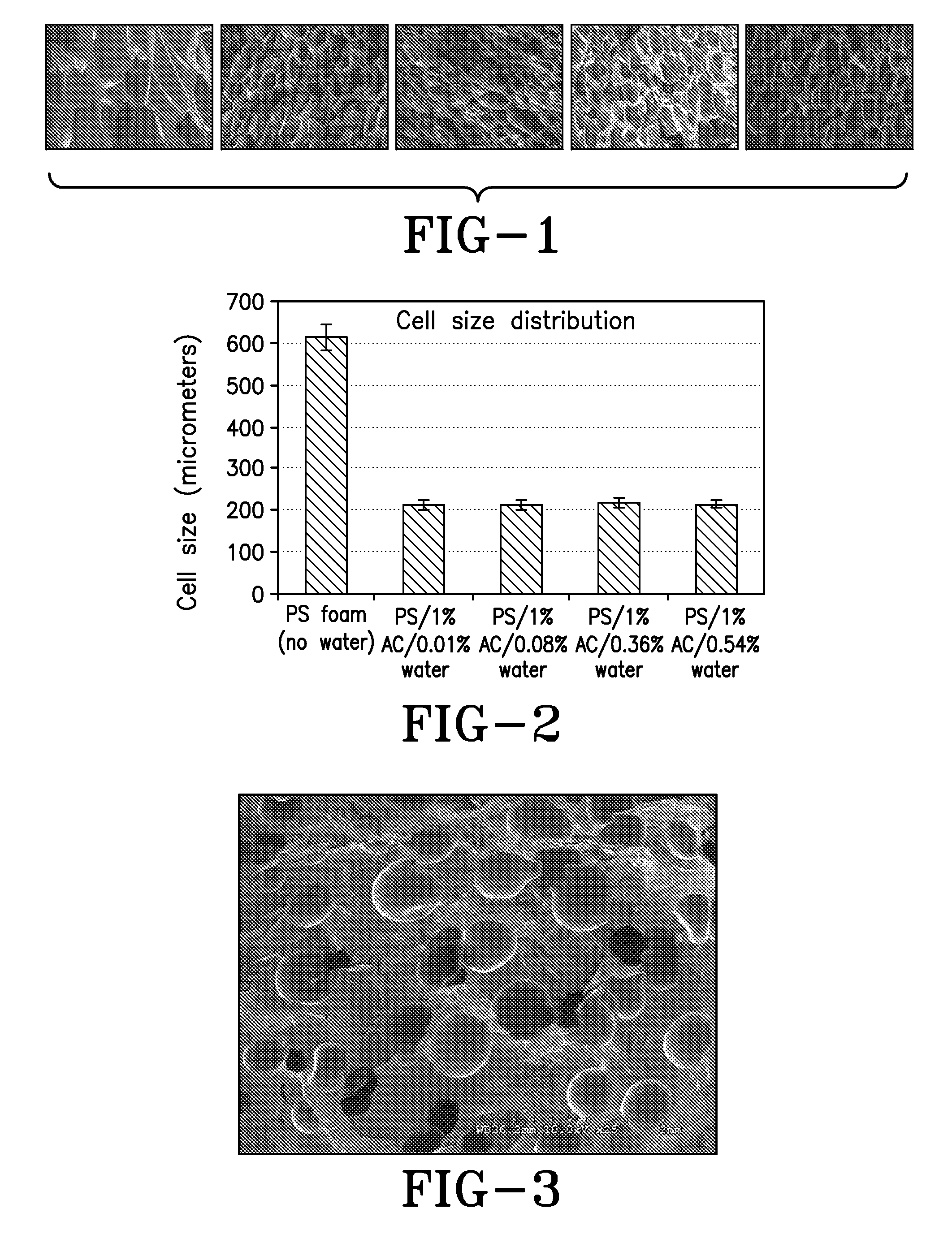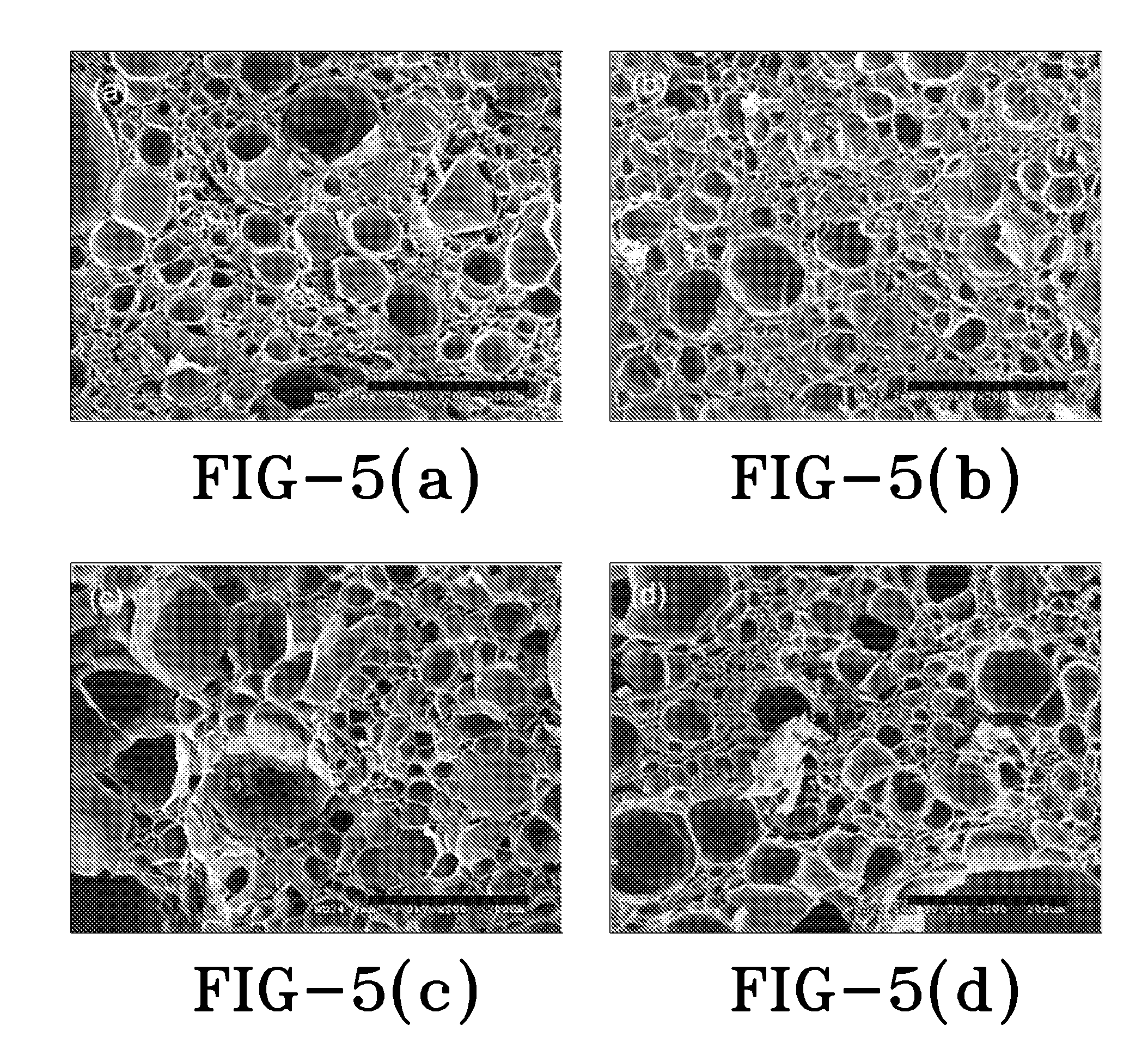Suspension polymerization and foaming of water containing activated carbon-nano/microparticulate polymer composites
- Summary
- Abstract
- Description
- Claims
- Application Information
AI Technical Summary
Benefits of technology
Problems solved by technology
Method used
Image
Examples
example 1
[0073]53 g of polystyrene, 0.25 g of AlBN, 0.15 g of BPO, and 3 g of activated carbon containing 7.5 g of water were mixed with 47 g of styrene. The mixture was kept overnight at room temperature. The viscous solution (around 100 g) was suspended in water (300 g) with the aid of suspension stabilizers, hydroxyethyl cellulose (HEC) (0.6 wt % based on the suspension water) and PVA (0.005 wt % based on suspension water), at 80° C. at a high stirring rate (800 rpm). During the polymerization, the stirring rate and temperature were kept at 600 rpm and 90° C. respectively. After approximately 5 hours, the suspension was transferred to an autoclave and post-cured at 120° C. under 100 psi for 12 hours to achieve complete reaction. Finally, the suspension was cooled to room temperature. The spherical black beads were washed and stored in water. Water on the surface of PS / AC beads was removed before extrusion.
example 2
[0074]53 g of polystyrene, 0.25 g of AlBN, 0.15 g of BPO, 3 g of nanoclays, and 3 g of activated carbon containing 7.5 g of water were mixed with 47 g of styrene. The mixture was kept overnight at room temperature. The viscous solution (around 100 g) was suspended in water (300 g) with the aid of suspension stabilizers, HEC (0.6 wt % based on the suspension water) and PVA (0.005 wt % based on suspension water), at 80° C. at a high stirring rate (800 rpm). During the polymerization, the stirring rate and temperature were kept at 600 rpm and 90° C. respectively. After approximately 5 hours, the suspension was transferred to an autoclave and post-cured at 120° C. under 100 psi for 12 hours to achieve complete reaction. Finally, the suspension was cooled to room temperature. The spherical black beads were washed and stored in water. Water on the surface of PS / AC beads was removed before extrusion.
example 3
[0075]53 g of polystyrene, 0.25 g of AlBN, 0.15 g of BPO, 3 g of carbon nanofibers, and 3 g of activated carbon containing 7.5 g of water were mixed with 47 g of styrene. The mixture was kept overnight at room temperature. The viscous solution (around 100 g) was suspended in water (300 g) with the aid of suspension stabilizers, HEC (0.6 wt % based on the suspension water) and PVA (0.005 wt % based on suspension water), at 80° C. at a high stirring rate (800 rpm). During the polymerization, the stirring rate and temperature were kept at 600 rpm and 90° C. respectively. After ˜5 h, the suspension was transferred to an autoclave and post-cured at 120° C. under 100 psi for 12 h to achieve complete reaction. Finally, the suspension was cooled to room temperature. The spherical black beads were washed and stored in water. Water on the surface of PS / AC beads was removed before extrusion.
PUM
| Property | Measurement | Unit |
|---|---|---|
| Fraction | aaaaa | aaaaa |
| Fraction | aaaaa | aaaaa |
| Percent by mass | aaaaa | aaaaa |
Abstract
Description
Claims
Application Information
 Login to View More
Login to View More - R&D
- Intellectual Property
- Life Sciences
- Materials
- Tech Scout
- Unparalleled Data Quality
- Higher Quality Content
- 60% Fewer Hallucinations
Browse by: Latest US Patents, China's latest patents, Technical Efficacy Thesaurus, Application Domain, Technology Topic, Popular Technical Reports.
© 2025 PatSnap. All rights reserved.Legal|Privacy policy|Modern Slavery Act Transparency Statement|Sitemap|About US| Contact US: help@patsnap.com



